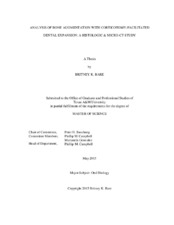| dc.description.abstract | The purpose of this study was to evaluate the effect of bone grafting when performed in association with corticotomies. A randomized split-mouth design was utilized in seven adult male beagle dogs. Corticotomies were performed with a piezosurgery unit adjacent to the maxillary second premolars. The experimental (Graft+) side additionally received bone grafting (demineralized freeze-dried bone graft, Straumann USA, Andover, MA) with a resorbable collagen membrane. The premolars underwent 9 weeks of archwire expansion, followed by 3 weeks of consolidation. Soft tissues measurements, including probing depth, attachment loss, and recession were obtained. Tooth movements were evaluated by intraoral, radiographic, and model measurements. Microcomputed tomography was used to quantify the surrounding bone and new bone formation was analyzed histologically using calcein and alizarin fluorescent labels and hematoxylin and eosin stains.
Results of the experiment showed that the Graft+ and control (Graft-) second premolars displayed similar amounts of expansion (~2.5 mm measured intraorally, and ~1.7 mm radiographically) and tipping. Bony dehiscences were visible on both the Graft+ and Graft- sides, with significantly (p=0.038) more bone loss over the mesial root on the Graft- than Graft+ side. New bone apposition was evident on the periosteal surface of buccal bone and surrounding graft particles on the Graft+ side. Mineralized particulate graft material was evident at the apical aspect of the roots. Histologically, graft incorporation into host bone occurred along the buccal surface of the expanded tooth root, with greater bone volume present apically than coronally. Bone material density (mg HA/cm^3) was found to be significantly (p=0.028) greater on the grafted side.No significant differences were found for any second premolar soft tissue measurement, or for tooth and root heights between the Graft+ and Graft- sides.
Within the context of this study, we can conclude that while new bone formation occurs after bone grafting in combination with corticotomies, it is mostly limited to the more apical aspect of the tooth root. Although the soft tissue periodontium was not detrimentally affected, bony dehiscence formation was not prevented with the bone grafting procedure. | en |


